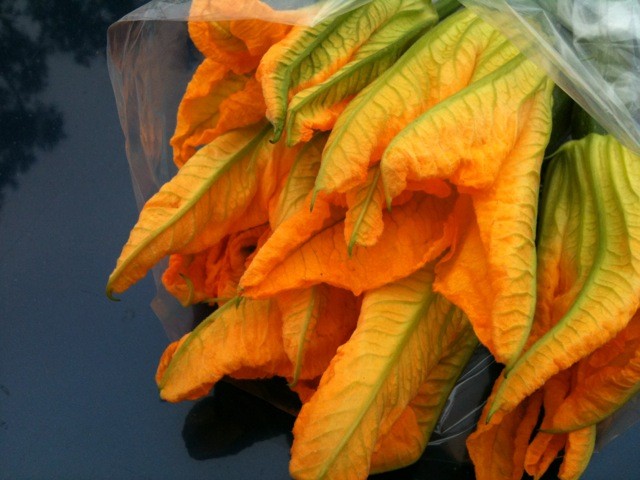Since the recipe yesterday involved fresh squash blossoms, it seemed like a good time to explore the ins and outs of the bright yellow or orange flowers.

]
Edible blossoms form on all squashes, both summer and winter, so they
are typically available fresh from April until well into December.
Plants produce both male and female flowers; female flowers form on the
end of a squash and male flowers do not. Both are open together for only
one morning, meaning that bees or humans must pollinate the female
blossoms in order for there to be squash. Typical squash plants produce
three times as many male flowers as female to increase the chance of
fruiting, which means that there will typically be more male flowers for
sale than female.
The most common preparation of squash blossoms is to stuff them with
seasoned soft cheese, close them, dip them into a light batter, and deep
fry them until golden brown. This preparation requires the freshest
male blossoms; fresh for ease of stuffing the flower, and male so that
the attached vine stem can be used as a handle while frying.
Yesterday's recipe for quesadillas is agnostic as to the flower's
gender. Female blossoms with tiny squashes attached are often sold as
farmers try to thin the impending glut of squash. The tiny squash is
perfectly edible and is, in fact, softer and sweeter than fully mature
squash. (Bonus fact: when I lived in the Midwest, the only time I ever
locked my car was in August, because well-meaning but desperate
neighbors would leave bags of giant, woody zucchini in my front seat if I
didn't.)
Other suggestions for the flowers: shred them and toss them into salads
for a slightly nutty taste and a splash of color; stir them into risotti
or pilafs; sautéed with shallot until wilted, then piled on grilled
slices of good bread; tossed into clear zucchini soup.
If you are going to stuff the blossoms, buy them fully opened (the
specimens from Sweredoski Farms at the Irvine farmers' market are the
finest quality I've ever seen); if you are going to cook them down or
shred them, then the piles of slightly wilted blossoms will do you
fine. Avoid blossoms that have turned brown, and as with any leaves,
slimy is never a good thing. Wrapped like herbs in a damp paper towel
and stored in a zip-top bag in your refrigerator's crisper, you may get
four or five days out of them, but for best results use them the day you
buy them.

